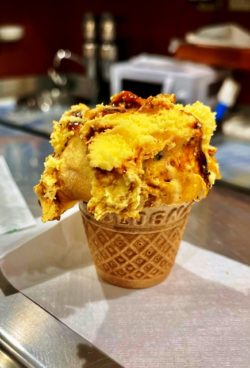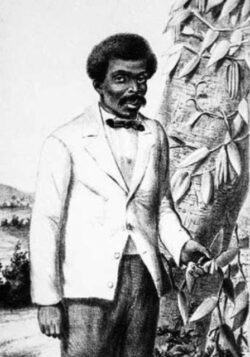Read Time: 5 Minutes Subscribe & Share
Gelato Concerns
 One of the things I found to fret about when we moved to Bologna was how serious a threat Italian gelaterie would pose to my physical well being. There are several excellent ones within waddling distance of our apartment. Would we succumb to trying out different flavors and combinations every day, or limit it to once a week? I needn’t have worried. We treat ourselves to gelato infrequently (I always get it in a cup not a cone, as the cone just gets in the way of the ice cream). While I like to venture into such combinations as ricotta and fig or zabaglione with rum-soaked raisins, the RWM (Resident Wine Maniac) always and forever chooses Vanilla (or very slight variations on the V theme).
One of the things I found to fret about when we moved to Bologna was how serious a threat Italian gelaterie would pose to my physical well being. There are several excellent ones within waddling distance of our apartment. Would we succumb to trying out different flavors and combinations every day, or limit it to once a week? I needn’t have worried. We treat ourselves to gelato infrequently (I always get it in a cup not a cone, as the cone just gets in the way of the ice cream). While I like to venture into such combinations as ricotta and fig or zabaglione with rum-soaked raisins, the RWM (Resident Wine Maniac) always and forever chooses Vanilla (or very slight variations on the V theme).
Such narrow mindedness makes my eyes roll, but it turns out he is not alone. Vanilla is the overriding favorite flavor globally, but its success has been no easy journey. What has become the second most expensive spice in the world – the first being saffron – owes its current cultivation method to a 12-year-old enslaved child on the island of Réunion. Vanilla pod-bearing orchids in Mexico originally were pollinated haphazardly by a variety of bees or hummingbirds. The blossoms, according to the National Geographic, open and fall to the ground within 24 hours, if not pollinated. Stressful work for hummingbirds and bees and kind of a crapshoot for producers. As the spice trade grew within Europe, countries that had grabbed real estate in tropical areas, went on to enslave local populations or brought them in from other colonized territories and laid out plantations for spices such as vanilla.
Reproductive Issues
Assisted reproduction methods remained elusive. Ever since Spain had first imported cocoa and vanilla to Europe in the 16th century, the propagation and cultivation of vanilla as commercial crops such as sugar cane, nutmeg and pepper, had been an enduring mystery, according to Wikipedia. It was not until 1836 that Charles Morren, a Belgian botanist, proved that the temperamental vanilla orchids require outside manipulation to produce the pods. This was an advance, but his method of pollination was too cumbersome to be commercially viable.
In 1841, a 12-year-old on a plantation in Réunion devised the method that is used today. The plantation owner who had enslaved Edmond Albius taught him the rudiments of botany, and from that knowledge, the child developed a simple and economical method of artificially pollinating the temperamental blossoms. His invention was implemented throughout the existing vanilla plantations in the Indian Ocean and allowed for further vanilla cultivation back in Brazil and Africa. Edmond Albius was never rewarded by the French government for his extremely cost-effective and profitable method. In 1848 France abolished slavery in its colonies, and Edmond moved off the plantation and worked as a kitchen servant in St Denis in Réunion. He was later convicted of stealing jewelry and sentenced to ten years in prison. The French government, as a sign of their gratitude, commuted his sentence after five years. Edmond Albius died in poverty in Réunion in 1880.
plantation owner who had enslaved Edmond Albius taught him the rudiments of botany, and from that knowledge, the child developed a simple and economical method of artificially pollinating the temperamental blossoms. His invention was implemented throughout the existing vanilla plantations in the Indian Ocean and allowed for further vanilla cultivation back in Brazil and Africa. Edmond Albius was never rewarded by the French government for his extremely cost-effective and profitable method. In 1848 France abolished slavery in its colonies, and Edmond moved off the plantation and worked as a kitchen servant in St Denis in Réunion. He was later convicted of stealing jewelry and sentenced to ten years in prison. The French government, as a sign of their gratitude, commuted his sentence after five years. Edmond Albius died in poverty in Réunion in 1880.
The Vanilla Triumvirate
Today there are three types of vanilla pods grown commercially, even though there exist over one hundred varieties of orchids that can bear similar pods. Vanilla Planifolia is also called Bourbon Vanilla (it does not mean that it has been macerated in our Bourbon whiskey) and is the original name bestowed by the French government on the island of Réunion -it is still a département of France. In 1964 the French government trademarked the name Bourbon Vanilla to be attached only to vanilla planifolia that was grown in Réunion, Madagascar, Mauritius and Comoros. The grading and descriptors used in vanilla beans are very poorly regulated, but here goes. Bourbon vanilla bean is a Grade ‘A” which means they are of a certain length, have a moisture content of around 30% and the pods bear no splits in the outer skin. They are plump and yield a creamy and sweet vanilla flavor. A grade B vanilla pod will be drier, less plump and may have splits or other disfigurations. Within this rather wobbly category are beans that are shorter in length or dryer from less careful harvesting. They are the cheaper beans you see in grocery stores and are used in making some generic vanilla extracts.
Tahitensis Vanilla owes its existence to a different vanilla-bearing orchid found in a private garden on the island in 1848. It is now grown commercially in French Polynesia and New Guinea. Fleshy and powerfully aromatic, their pods turn reddish brown in appearance rather than the black-tinged brown of the Planifolia variety. Unlike the Planifolia, the beans are almost oily on the surface and should also be quite plump when you buy them. Tahitian vanilla loses a lot of its appealing aroma and flavor when exposed to heat, so you should use it only to flavor refrigerated or frozen recipes. Its fruity and floral flavors and aromas make it a good choice for a savory application if no heat is applied.
The third variety of vanilla bean is the Pompona, which may be the descendant of the vanilla bean prized by the indigenous people of Mexico. It is not an easy vanilla bean to grow  commercially and is used in the perfume industry. It is rumored that Guerlain may have used it in his creation of the Shalimar perfume profile – but synthetic vanillin is used in the actual perfume. The pods are longer and plumper than the Planifolia and Tahitensis beans. While I have used both Mexican Planifolia, Bourbon Planifolia and Tahitensis vanilla beans, this one is quite new to me. A hybrid of the Planifolia and Pompona vanilla bean is now being cultivated in Madagascar. Most Mexican vanilla beans, however, are a Planifolia variety and have distinct flavors and aromas of raisins and wood. I love it in fruit-based desserts.
commercially and is used in the perfume industry. It is rumored that Guerlain may have used it in his creation of the Shalimar perfume profile – but synthetic vanillin is used in the actual perfume. The pods are longer and plumper than the Planifolia and Tahitensis beans. While I have used both Mexican Planifolia, Bourbon Planifolia and Tahitensis vanilla beans, this one is quite new to me. A hybrid of the Planifolia and Pompona vanilla bean is now being cultivated in Madagascar. Most Mexican vanilla beans, however, are a Planifolia variety and have distinct flavors and aromas of raisins and wood. I love it in fruit-based desserts.
Below is a quick video from Norohy on the processing of vanilla beans in Madagascar, which gives you a good overview of the intense labor that is involved in the production of vanilla. This company under the umbrella of Valrhona in France, is committed to an ethical and sustainable approach to this valuable spice.
Superior Sources
When the shop was in existence, I found that Nielsen Massey was a remarkably good source for vanilla beans, extracts and powders. A KD reader, however, has written to me about the marvels of Slofoodgroup.com, which has the most amazing variety of vanilla beans, including Pompona varieties grown in Costa Rica and Peru. They ship internationally, so I am eager to explore. As I’m happily destined to spend my life with a Vanilla Obsessive, it’s nice to know that we have options.

Kitchen Detail shares under the radar recipes, explores the art of cooking, the stories behind food, and the tools that bring it all together, while uncovering the social, political, and environmental truths that shape our culinary world.




Comments are closed here.
Follow this link to create a Kitchen Detail account so that you can leave comments!